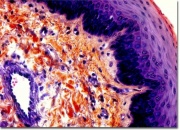Difference between revisions of "Epidermis"
Jump to navigation
Jump to search
(username removed) |
|||
| (3 intermediate revisions by 3 users not shown) | |||
| Line 1: | Line 1: | ||
[[File:HautAufbauf5.jpg|thumb|Drawing of skin structure]] | [[File:HautAufbauf5.jpg|thumb|Drawing of skin structure]] | ||
== Description == | == Description == | ||
| − | + | [[File:epidermis4large.jpg|thumb|Epidermis]] | |
| − | The outermost, nonsensitive layer of [ | + | The outermost, nonsensitive layer of [[skin]] in an animal or a plant. [[Epidermis]], or [[cuticle]], covers the middle [[dermis]] (cutis, corium) layer while the innermost layer is known as the [[hypodermis]] (subcutis). In humans, the epidermis is composed of four layers, which are (from the outside): |
1) a layer of dead, horny, flattened cells that form a continuous membrane, | 1) a layer of dead, horny, flattened cells that form a continuous membrane, | ||
| Line 14: | Line 14: | ||
The epidermis provides protection from water, sunlight, dirt, bacteria, and other potentially dangerous materials. In dehairing processes, the epidermis is attacked by enzymes or alkalis. | The epidermis provides protection from water, sunlight, dirt, bacteria, and other potentially dangerous materials. In dehairing processes, the epidermis is attacked by enzymes or alkalis. | ||
| − | |||
== Synonyms and Related Terms == | == Synonyms and Related Terms == | ||
epithelial cells; | epithelial cells; | ||
| − | == | + | ==Resources and Citations== |
| − | |||
| − | |||
| − | |||
| − | |||
| − | * | + | * Hermann Kuhn, ''Conservation and Restoration of Works of Art and Antiquities'', Butterworths, London, 1986 |
| − | * | + | * Mary-Lou Florian, Dale Paul Kronkright, Ruth E. Norton, ''The Conservation of Artifacts Made from Plant Materials'', The Getty Conservation Institute, Los Angeles, 1990 |
| − | * | + | * Olympus Microscopy Resource Center at http://www.olympusmicro.com/galleries/abramowitz/index.html |
| − | * Wikipedia | + | * Wikipedia: http://en.wikipedia.org/wiki/Epidermis (Accessed Nov. 2, 2005) |
| − | * | + | * Random House, ''Webster's Encyclopedic Unabridged Dictionary of the English Language'', Grammercy Book, New York, 1997 |
* ''The American Heritage Dictionary'' or ''Encarta'', via Microsoft Bookshelf 98, Microsoft Corp., 1998 | * ''The American Heritage Dictionary'' or ''Encarta'', via Microsoft Bookshelf 98, Microsoft Corp., 1998 | ||
Latest revision as of 07:38, 2 August 2022
Description
The outermost, nonsensitive layer of Skin in an animal or a plant. Epidermis, or Cuticle, covers the middle Dermis (cutis, corium) layer while the innermost layer is known as the Hypodermis (subcutis). In humans, the epidermis is composed of four layers, which are (from the outside):
1) a layer of dead, horny, flattened cells that form a continuous membrane,
2) a layer of oily transparent cells,
3) one or more layers of granular cells and
4) a layer of rounded pigmented cells.
The epidermis provides protection from water, sunlight, dirt, bacteria, and other potentially dangerous materials. In dehairing processes, the epidermis is attacked by enzymes or alkalis.
Synonyms and Related Terms
epithelial cells;
Resources and Citations
- Hermann Kuhn, Conservation and Restoration of Works of Art and Antiquities, Butterworths, London, 1986
- Mary-Lou Florian, Dale Paul Kronkright, Ruth E. Norton, The Conservation of Artifacts Made from Plant Materials, The Getty Conservation Institute, Los Angeles, 1990
- Olympus Microscopy Resource Center at http://www.olympusmicro.com/galleries/abramowitz/index.html
- Wikipedia: http://en.wikipedia.org/wiki/Epidermis (Accessed Nov. 2, 2005)
- Random House, Webster's Encyclopedic Unabridged Dictionary of the English Language, Grammercy Book, New York, 1997
- The American Heritage Dictionary or Encarta, via Microsoft Bookshelf 98, Microsoft Corp., 1998

